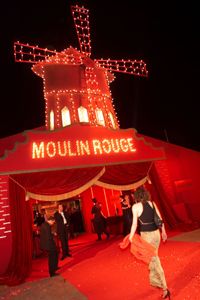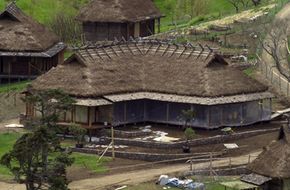Jobs in Film Set Construction
The production designer is the head of the art department, which employs the most people and takes up most of the budget on a feature film. The production designer needs to be a master of many skills: a filmmaker, an artist, an interior designer. He also needs experience in physical construction like carpentry, plastering, welding and painting. And, he has to be able to work with everybody from directors to producers to art department interns. Production designers have years of experience in the business, working up from art directors, set dressers and construction managers.
The production designer defines the film's artistic vision, but it's the art director's job to carry it out. The art director manages a huge team of workers with wildly different responsibilities. The art director leads a team of draftsmen who design the sets, then coordinates with the construction manager to actually build them. The art director works closely with the set dressers and props masters to realize the production designer's vision. The art director is also the contact for all third-party special effects work. Meanwhile, the art director has to consult with accountants and producers to make sure the production stays on budget.
Advertisement

Construction managers are in charge of everything related to the physical construction of the film sets. He's part of the early planning process, helping the production designer decide how many sets need to be built and what they will cost. The construction manager hires all of the construction department heads and skilled workers and is responsible for ordering all supplies and negotiating the best prices. He is also in charge of transporting supplies to location shots and striking (taking down) the set after shooting is finished. Construction managers have years of film production experience as carpenters, painters, riggers, welders and plasterers. And most have construction experience outside of film as well. The construction manager has the tough job of being the liaison between the artists and the construction workers, a responsibility that requires excellent communication and interpersonal skills.
Set dressers or set decorators are in charge of assembling all of the design elements of a set that aren't mailed down. They need to work closely with the production designer and art director to track down all of the props, furniture, decorations and small physical details that populate the fictional world of the film. One of the set dressers main worries is continuity. If there are several scenes in the same location, then all of the set elements need to be in the same place. The set dresser works closely with the prop master to make sure that an actor's glass is filled to the same level for each take, or that a throw pillow doesn't mysteriously disappear from one shot to the next.
But these are only a fraction of the hundreds of jobs required to build a film set. For example, in the painting department alone, there's the department head, a supervising painter, regular painters and standby painters. In the art department, there are supervisors, assistants, standbys and runners of every kind.
The typical career path is to receive some kind of art or design education, then work your way up through the art department or construction department. The hours on film sets are highly irregular and long, but the work can be tremendously creative and satisfying.
For even more information on film production and related topics, check out the links below.
Related HowStuffWorks Articles
More Great Links
Sources
- "Art Department Overview." Skillset.org. http://www.skillset.org/film/jobs/productiondesign/article_4644_1.asp
- "Art Direction: The Visual Language of Film." Oscars.org. http://www.oscars.org/teachersguide/artdirection/introduction.html
- "Art Director." Skillset.org. http://www.skillset.org/film/jobs/productiondesign/article_4669_1.asp
- "Career: Set Designers." CollegeBoard.com. http://www.collegeboard.com/csearch/majors_careers/profiles/careers/105457.html
- "Construction Department Overview." Skillset.org. http://www.skillset.org/film/jobs/construction/article_1776_1.asp
- "Construction Manager." Skillset.org. http://www.skillset.org/film/jobs/construction/article_4060_1.asp
- "Oscar-Nominated Set Design." Architectural Digest. http://www.architecturaldigest.com/homes/features/2008/03/sets_slideshow_032008?showall=true
- "Re-Creating the Feel of Pre-World War II Tokyo on a California Horse Ranch." Turrentine, Jeff. Architectural Digest. March 2006. http://www.architecturaldigest.com/homes/hollywood/archive/geisha_article_032006
- "Set Decorator/Assistant Set Decorator." Skillset.org. http://www.skillset.org/film/jobs/productiondesign/article_4675_1.asp
